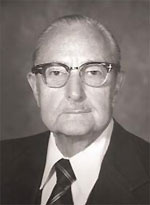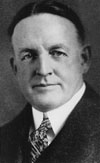The Department of Psychiatry has been led by these 8 chairs:
*Interim
2007–Present Dr. Gregory Dalack
1985–2007 Dr. John F. Greden
1984–1985 Dr. Robert Friedel
1983–1984 Dr. George Curtis*
1981–1982 Dr. Barney Carroll*
1971–1980 Dr. Albert Silverman

Albert J. Silverman, M.D., C.M.
1925 - 2002
Albert Jack Silverman, M.D., C.M., a noted psychiatrist, neuroscience researcher and former chair of two university psychiatry departments, died in Santa Barbara, California on Friday, May 10, 2002. He was 77.
In the mid-1950s, Silverman led research for the U.S. Air Force on space neuroscience and psychology, which rose from obscurity to prominence literally overnight in 1957 with the launch of Sputnik and the dawn of the space race. In addition to performing key research on physical and psychological responses to G-force acceleration and space travel as chief of the stress and fatigue section of the Aero Medical Laboratory at Wright-Patterson Air Force Base, he helped invent a device that used pilots' brain waves as an oxygen-deprivation warning system.
During his career, Silverman sought to bridge the divide between the rising field of neuroscience-based psychiatry and traditional psychoanalysis. In 1963, he was one of three founders of the Rutgers Medical School and chaired its first psychiatry department. The school later became part of the New Jersey Medical School at the University of Medicine and Dentistry of New Jersey.
In 1970, he became chair of psychiatry at the University of Michigan Medical School. He is credited with redirecting the department's research, education and treatment programs, and leading during a time of great change. He returned to research and clinical care in 1981, and retired in 1990, but continued as professor emeritus. Today's event is the 18th in an annual series of research conferences held in his honor.
"Al was truly a force to be reckoned with, an international leader in the field of psychosomatic medicine, and an important figure in the development of psychiatry at Michigan and beyond into a field that embraces all aspects of the human brain and psyche," says John Greden, M.D., current department chair and executive director of the U-M Depression Center. "We will miss him terribly, but we know that his contributions will live on."
He is survived by his wife Halina W. Silverman; son Barry Evan Silverman (Nancy); daughter Marcy Silverman Mullan (John); four grandchildren, Luke, Kelly, Erin and Mark; and brother Marvin Silverman, M.D. of Ottawa, Canada and his family.
Silverman served on the National Board of Medical Examiners for many years, including a term from 1984 to 1987 as chair of the committee that designed the behavioral sciences portion of the national medical licensing examination. From 1975 to 1976, he was president of the American Psychosomatic Society, which focuses on the mind-body connection in disease.
A native of Montreal, where he was born on Jan. 27, 1925, Silverman earned his bachelor's of science and medical degrees at McGill University. It was at McGill that he discovered his interest in the physical underpinnings of psychological phenomena - a field called psychophysiology. After a residency in psychiatry at the University of Colorado Medical Center, he followed his mentor Ewald W. Busse to Duke University, where he became a member of the faculty.
He was naturalized as an American citizen in June 1955, and entered the Air Force that year. During his two and one-half years of service at Wright-Patterson Air Force Base, he completed his board examinations in both neurology and psychiatry.
In a 1991 oral history interview, Silverman recalled his Air Force experience:
"This was right at the beginning of space exploration. Just prior to the Russians' putting up Sputnik, we were doing G-tolerance studies with the human centrifuge. We weren't allowed to call them moon trajectories or anything like that, because the senators were very negative about 'all of this space nonsense.' But in under 24 hours of Sputnik's going up, we got these hurry-up telegrams from headquarters saying, 'What are we doing in space [research]?'. So we dusted off all the old technical reports we had been doing anyway, but under non-space names such as 'acceleration in unusual environments.' That kind of vague name now became, 'G-forces necessary for a moon trip,' which now became very kosher." Silverman left the service as a captain in 1957. He returned to Duke, heading the psycho-physiology lab and then the behavior studies lab until leaving for Rutgers in 1963. In all, his research during this period of his career led to more than 100 publications and presentations.
He studied psychoanalysis at the Washington Psychoanalytic Institute, graduating in May 1964. After founding the Rutgers psychiatry department, Silverman left New Jersey when the state merged several medical programs under a new structure.
At the U-M, he set out to bridge the gap between the Mental Health Research Institute, home to noted basic research in the neurosciences, and the psychoanalysis-focused psychiatry faculty. In addition to strengthening the clinical trials program, he helped the U-M implement new clinical treatments and research programs emphasizing psychopharmacology, biofeedback, and stress-neuroendocrine relationships. He also revamped the curriculum for medical students to include more psychiatric training, improved the residency program, and attracted young neuroscientists.
In addition to the NBME and APS, Silverman was a charter fellow of the American College of Psychiatrists; a fellow of the American Association for the Advancement of Science, the American Academy of Psychoanalysis and the American College of Neuropsychopharmacology; a former chairman of several committees for the American Psychiatric Association; and an honorary fellow of the American Society of Psychoanalytic Physicians.
An amateur musician and sculptor, Silverman was a patron of the U-M University Musical Society, a friend of the U-M Museum of Art, and a Patron of the Detroit Institute of Arts.
We hold this conference in fond memory of Dr. Silverman, visionary, healer, and friend.
1937–1970 Dr. Raymond Waggoner (MD ’24)

Raymond W. Waggoner, M.D.
1901–2000
Many of us knew Ray as a wise, dedicated leader of APA (President, 1969–1970; Distinguished Service Award, 1988) and a pivotal voice in American psychiatry for half a century. We in Michigan knew him also as a dominant force in Michigan medicine and psychiatry for many years.
Ray always wanted to be a doctor. In fact, at the age of 5 he began carrying a doctor’s bag with him wherever he went. He became an M.D. at the tender age of 22 and has been a pioneer, innovator, and benefactor ever since. Ray did not really plan to be a psychiatrist; rather, he contemplated becoming a neurosurgeon. He ended up receiving training in both neurology and psychiatry and was considered a neuropsychiatrist. He was Chair of the Department of Psychiatry at the University of Michigan from 1937 to 1970. He immediately set up a three-room psychiatric unit, one of the first units in a general hospital in the country. Dr. Waggoner built an eclectic department with breadth and class, an academic model for the nation. He was a superb administrator, and the department grew and prospered under his strong leadership.
In a tribute to Dr. Waggoner, Dr. John Greden, Executive Director of the University of Michigan Comprehensive Depression Center, noted that Dr. Waggoner’s department contained “a healthy eclecticism, diversity and vibrancy, excellent clinical services, and scholarly teaching and research. Clearly, Dr. Waggoner has helped to establish the Michigan tradition of excellence that we proudly inherit and build upon.” Ray was a jet setter before jets, a mover and shaker at home and abroad.
Ray has left a fabulous legacy. What I recall vividly is his caring. He has helped the careers of many, indeed he has taught an entire generation of mental health professionals—a living legacy of psychiatrists and professionals in other disciplines who trained under and with him. He has changed the field of psychiatry and has aided and supported many people in a myriad of ways. He has been a true and loyal friend!
Dr. Waggoner was always ahead of his time, e.g., in his attempts to bridge the gap between the Freudian (psychological) model and biological (neuroscience) model by nurturing a healthy dynamic tension between the two. He presaged and encouraged the biopsychosocial model of today, early on seeing mental illness as both an emotional and physical problem. He always considered the patient as a total person. He was the “compleat physician,” whether consulting with Masters and Johnson or integrating medical and psychiatric care by developing a first-rate consultation- liaison service.
In the 1940s, Ray helped to standardize the mental fitness criteria used in screening potential soldiers in the Selective Service. He also advised the U.S. Surgeon General on the psychological effects of World War II and the Allied Occupation in Germany and Japan. After the war, he helped devise the selection process for the Peace Corps, where I first met Dr. Waggoner and tried to keep up with this whirlwind of a man—a dynamo who is perhaps best remembered as a consummate administrator who listened to opinions and then made decisions. I remember him as an optimist, always feeling that with the right tools we could accomplish what others considered impossible. And he often did.
Ray also had a strong interest in ethics and values, which he saw as combining the human and humane. In fact, in 1995 the University of Michigan established the Raymond W. Waggoner Lectureship on Ethics and Values in Medicine in his honor. Indeed, Dr. Waggoner was a giant in his time and serves as an inspiration to us all.
PHILIP M. MARGOLIS, M.D.
1906–1936 Dr. Albert Barrett

Albert M. Barrett, M.D.
1871 - 1936
Albert Moore Barrett was born in Austin, Illinois, July 14, 1871. Barrett married Eliza Jane Bowman of Clinton, IA, July 8, 1905; they had one son (Edward Bowman). Albert Barrett received his BA (1893) and his MD (1895) from the State University of Iowa. After his medical school training, Barrett was pathologist at the Iowa State Asylum for the Insane at Independence (1895-1897), then assistant physician at the Massachusetts State Hospital for the Insane at Worcester where he worked under the supervision of Adolf Meyer (1897-1898). Between 1898 and 1906, with a break to pursue additional training, Barrett was the pathologist at the Danvers Insane Hospital in Massachusetts. Between 1900 and 1902, Barrett did post-graduate training in psychiatry in Germany with such luminaries as Emil Kraepelin. He was assistant in neuropathology in the Harvard University Medical School (1905-6), but in 1906 was appointed by the University of Michigan to be Associate Professor of Neuropathology, Director of the Psychopathic Ward, and Pathologist of the State Asylums. In 1907, Barrett became Professor of Psychiatry and Nervous Diseases in the Department of Medicine and Surgery. Between 1920 and his sudden death in 1936, Barrett was Professor of Psychiatry at the University of Michigan Medical School.
Barrett was involved in a variety of professional organizations, and was active on many national committees. Barrett was a member of the Medical Council of U.S. Veterans Bureau, the American Medical Association, the American Psychiatric Association, the American Psycho-Pathological Association (president 1923-34), the Central Neuro-Psychiatric Association (president 1925), the American Neurological Association (president 1935-36), Nu Sigma Nu, Sigma Xi, and Alpha Omega. He was president of the APA at an important and formative time of its history (1921-22). At one time, Barrett was the chairman of the Committee on Statistics for the National Committee for Mental Hygiene. Barrett also helped to found the Michigan Society for Mental Hygiene in 1920, as well as the Detroit Society for Neurology and Psychiatry. In his lifetime, he published and presented over 35 papers (including works published in journals such as the American Journal of Medical Sciences, American Journal of Insanity, Journal of Mental and Nervous Diseases, Journal of the Michigan State Medical Society, Journal of the American Medical Association, and the Archives of Neurology and Psychiatry).



